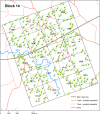The impact of hotspot-targeted interventions on malaria transmission: study protocol for a cluster-randomized controlled trial
- PMID: 23374910
- PMCID: PMC3576332
- DOI: 10.1186/1745-6215-14-36
The impact of hotspot-targeted interventions on malaria transmission: study protocol for a cluster-randomized controlled trial
Abstract
Background: Malaria transmission is highly heterogeneous in most settings, resulting in the formation of recognizable malaria hotspots. Targeting these hotspots might represent a highly efficacious way of controlling or eliminating malaria if the hotspots fuel malaria transmission to the wider community.
Methods/design: Hotspots of malaria will be determined based on spatial patterns in age-adjusted prevalence and density of antibodies against malaria antigens apical membrane antigen-1 and merozoite surface protein-1. The community effect of interventions targeted at these hotspots will be determined. The intervention will comprise larviciding, focal screening and treatment of the human population, distribution of long-lasting insecticide-treated nets and indoor residual spraying. The impact of the intervention will be determined inside and up to 500 m outside the targeted hotspots by PCR-based parasite prevalence in cross-sectional surveys, malaria morbidity by passive case detection in selected facilities and entomological monitoring of larval and adult Anopheles populations.
Discussion: This study aims to provide direct evidence for a community effect of hotspot-targeted interventions. The trial is powered to detect large effects on malaria transmission in the context of ongoing malaria interventions. Follow-up studies will be needed to determine the effect of individual components of the interventions and the cost-effectiveness of a hotspot-targeted approach, where savings made by reducing the number of compounds that need to receive interventions should outweigh the costs of hotspot-detection.
Trial registration: NCT01575613. The protocol was registered online on 20 March 2012; the first community was randomized on 26 March 2012.
Figures


References
-
- Woolhouse ME, Dye C, Etard JF, Smith T, Charlwood JD, Garnett GP, Hagan P, Hii JL, Ndhlovu PD, Quinnell RJ, Watts CH, Chandinawa SK, Anderson RM. Heterogeneities in the transmission of infectious agents: implications for the design of control programs. Proc Natl Acad Sci USA. 1997;94:338–342. doi: 10.1073/pnas.94.1.338. - DOI - PMC - PubMed
Publication types
MeSH terms
Substances
Associated data
Grants and funding
LinkOut - more resources
Full Text Sources
Other Literature Sources
Medical
Research Materials

